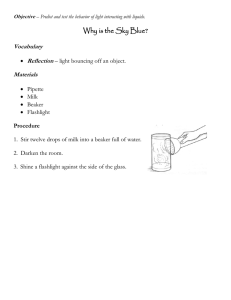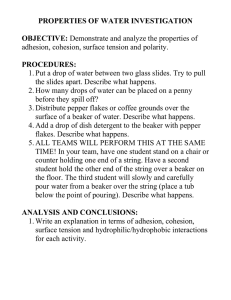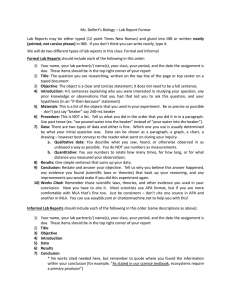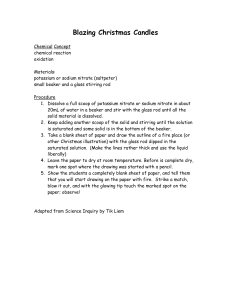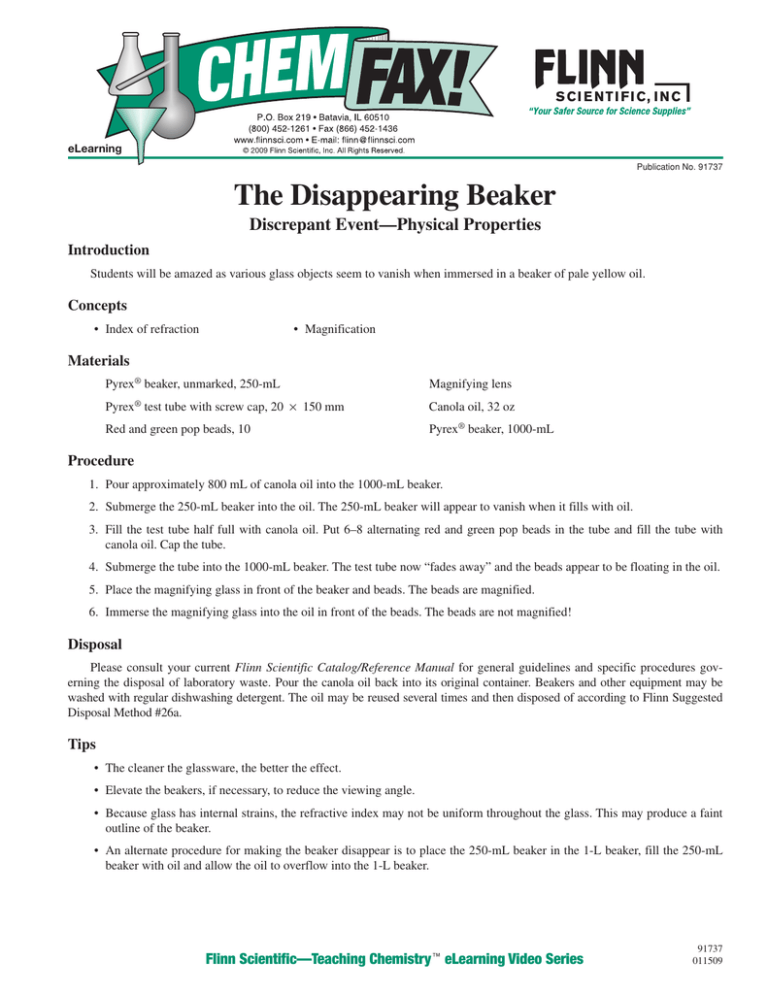
eLearning
2009
Publication No. 91737
The Disappearing Beaker
Discrepant Event—Physical Properties
Introduction
Students will be amazed as various glass objects seem to vanish when immersed in a beaker of pale yellow oil.
Concepts
• Index of refraction
• Magnification
Materials
Pyrex® beaker, unmarked, 250-mL
Magnifying lens
Pyrex® test tube with screw cap, 20 × 150 mm
Canola oil, 32 oz
Red and green pop beads, 10
Pyrex® beaker, 1000-mL
Procedure
1. Pour approximately 800 mL of canola oil into the 1000-mL beaker.
2. Submerge the 250-mL beaker into the oil. The 250-mL beaker will appear to vanish when it fills with oil.
3. Fill the test tube half full with canola oil. Put 6–8 alternating red and green pop beads in the tube and fill the tube with
canola oil. Cap the tube.
4. Submerge the tube into the 1000-mL beaker. The test tube now “fades away” and the beads appear to be floating in the oil.
5. Place the magnifying glass in front of the beaker and beads. The beads are magnified.
6. Immerse the magnifying glass into the oil in front of the beads. The beads are not magnified!
Disposal
Please consult your current Flinn Scientific Catalog/Reference Manual for general guidelines and specific procedures governing the disposal of laboratory waste. Pour the canola oil back into its original container. Beakers and other equipment may be
washed with regular dishwashing detergent. The oil may be reused several times and then disposed of according to Flinn Suggested
Disposal Method #26a.
Tips
• The cleaner the glassware, the better the effect.
• Elevate the beakers, if necessary, to reduce the viewing angle.
• Because glass has internal strains, the refractive index may not be uniform throughout the glass. This may produce a faint
outline of the beaker.
• An alternate procedure for making the beaker disappear is to place the 250-mL beaker in the 1-L beaker, fill the 250-mL
beaker with oil and allow the oil to overflow into the 1-L beaker.
Flinn Scientific—Teaching Chemistry eLearning Video Series
91737
011509
Discussion
Light travels at different speeds in various transparent media. For example, the speed of light in a vacuum is 3 × 108 m/s, in ice
2.29 × 108 m/s, in glycerin 2.04 × 108 m/s, and in rock salt 1.95 × 108 m/s.
When a light ray travels from one transparent medium through another one, the light ray bends.
The larger the difference of the speed of light in each medium, the more the light ray is bent.
To visualize this, construct a normal line to the interface of the two media and extend the line
through the second medium (Figure 1). If the speed of light is greater in the first medium, then the light
ray in the second medium bends towards the normal line (Figure 2). This bending of light is called
refraction. In addition, a fraction of the light is reflected off the interface between the two. Objects that
are clear can be seen because light is both refracted and reflected at the surface of the object.
Figure 1.
The ratio of the speed of light in a vacuum over the speed of light in a specific medium is called
its refractive index, n. Because the speed of light in air is so close to that in a vacuum, its refractive
index, 1.000293, is usually rounded off to 1.000 for calculations. Water has a refractive index of 1.33.
Pyrex glass has a refractive index of 1.474. If a Pyrex glass beaker is placed in another beaker filled
with water, the beaker can be seen, but not as clearly as it is seen when the Pyrex glass beaker is in air.
The clarity of a transparent object decreases as the refractive index values of two transparent media
approach each other, since reflection of light off the interface surface decreases and the angle light is
refracted in the second medium also decreases (Figure 3).
Figure 2.
When the two media have the same
refractive index, as with canola oil and Pyrex
glass, there is neither reflection nor refraction
(Figure 4), and the Pyrex glass “disappears”
in the canola oil.
A simple magnifying lens is a convex
lens that refracts parallel light to converge at
a single point called the principal focal point,
F (Figure 5). The distance from the lens to
the focal point is called the focal length, f.
Figure 3.
If an object is placed in
front of the lens at a distance
greater than the focal length,
a real, inverted and reduced
image is formed behind the lens
(Figure 6).
If the object is closer than
the focal length, an erect, virtual image is created that is
a magnification of the object
(Figure 7).
F
f
Figure 4.
Figure 5.
Canola oil has approximately the same refractive index as the magnifying lens. When the refractive index of the lens equals that
of the medium in which it is immersed, no refraction of light occurs and therefore the object is not magnified (Figure 8).
Figure 6.
Figure 7.
Figure 8.
–2–
© 2009 Flinn Scientific, Inc. All Rights Reserved.
91737
Connecting to the National Standards
This laboratory activity relates to the following National Science Education Standards (1996):
Unifying Concepts and Processes: Grades K–12
Evidence, models, and explanation
Content Standards: Grades 5–8
Content Standard B: Physical Science, transfer of energy
Content Standards: Grades 9–12
Content Standard B: Physical Science, interactions of energy and matter
Answers to Worksheet Questions
1. Describe what happened in this demonstration.
A large beaker was filled with canola oil. When a smaller beaker was placed inside, the smaller beaker seemed to disappear. The same thing happened to a test tube, though pop beads that were already in the tube did not. A magnifying glass,
though it could magnify the pop beads from outside the large beaker, did not from inside.
2. Define the following terms:
a. Refraction
Refraction is the bending of light towards a normal straight line when it passes through the second of two mediums.
b. Refractive index
The refractive index of a medium is the ratio of the speed of light in a vacuum over the speed of light in that medium.
3. The greater the difference between the refractive indexes of two materials, the easier it is too see a transparent object.
Knowing this, draw a conclusion about the refractive indexes of canola oil and Pyrex glass.
Since the Pyrex glass cannot be seen inside the canola oil, the refractive indexes of the two materials must be the same, as
no light is being allowed to reflect or refract off the Pyrex glass.
Acknowledgment
Special thanks to Lee Marek, Naperville HS, Naperville, IL, who provided Flinn Scientific with the instructions for this activity.
Reference
Disappearing Glass Rods; http://www.rom.on.ca/wwatch/teachers-kit/disappearing.html (Accessed Jan 2002).
Flinn Scientific—Teaching Chemistry™ eLearning Video Series
A video of the The Disappearing Beaker activity, presented by Lee Marek, is available in Discrepant Event—Physical
Properties, part of the Flinn Scientific—Teaching Chemistry eLearning Video Series.
Materials for The Disappearing Beaker are available from Flinn Scientific, Inc.
Materials required to perform this activity are available in the The Disappearing Beaker—Chemical Demonstration Kit available from Flinn Scientific. Materials may also be purchased separately.
Catalog No.
FB6264
Description
The Disappearing Beakers—Demonstration Kit
Consult your Flinn Scientific Catalog/Reference Manual for current prices.
–3–
© 2009 Flinn Scientific, Inc. All Rights Reserved.
91737
The Disappearing Beaker
Demonstration Worksheet
Discussion Questions
1. Describe what happened in this demonstration.
2. Define the following terms:
a. Refraction
b. Refractive index
3. The greater the difference between the refractive indexes of two materials, the easier it is too see a transparent object.
Knowing this, draw a conclusion about the refractive indexes of canola oil and Pyrex glass.
91737
© 2009 Flinn Scientific, Inc. All Rights Reserved. Reproduction permission is granted only to science teachers who have purchased Discrepant Event—Physical Properties in the Flinn Scientific—
Teaching Chemistry™ eLearning Video Series. No part of this material may be reproduced or transmitted in any form or by any means, electronic or mechanical, including, but not limited to photocopy, recording, or any information storage and retrieval system, without permission in writing from Flinn Scientific, Inc.

